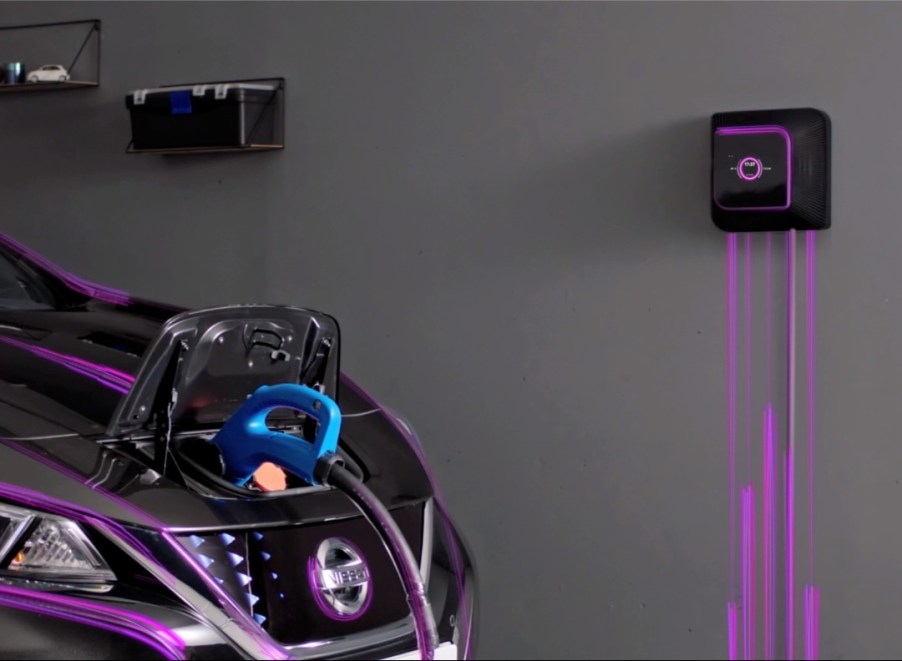
How This EV Charger May Finally Save You Money on Your Electric Bill
Because of how difficult it can be to find an EV charger, and long recharge times, many EV owners install home chargers. Recharging at home is also cheaper than charging at, say, McDonald’s, and more convenient. Park, plug it in and go to bed. But with how big modern battery packs can be, and how short commutes often are, EVs don’t necessarily have to be charged all that frequently. And if you’re not driving it, an EV is basically a giant battery.

Tesla, for instance, is planning on installing a powered outlet in the bed of the Cybertruck, to run lights or appliances. And Chevy’s hydrogen military truck can serve as a mobile power station. Shouldn’t you be able to tap into your EV’s battery to power your house, or sell power back to the grid? At this year’s CES, Spanish EV charger company Wallbox launched a charger that will let you do exactly that.
What’s special about the Wallbox Quasar EV charger?
The Wallbox Quasar is a bi-directional, or two-way EV charger, according to Motor Trend. Not only can it pull power from a house’s solar panels or from the grid to charge your EV, it can also tap into the EV’s batteries, for example, in case your power goes out.
Bi-directional chargers aren’t a new concept. However, what Wallbox has done is provide one that’s compact and relatively affordable. Normally, these types of vehicle-to-grid (V2G) chargers, such as Nuvve’s AC and DC products, are priced and scaled for fleet operations. But, the Quasar EV charger is roughly as big as other home Level 2 chargers, according to Electrek.
And, while the $4000 asking price is significantly more than other home chargers, the Quasar is much cheaper than the commercial-grade V2G chargers. It’s also one of, if not the, only such charger available in the US.
In addition, it’s possible homeowners may not have to pay the full $4000. MT reported that in the UK, where Wallbox launched the Quasar previously, utility company Octopus Energy offered its customers the EV charger for next to nothing. The only provision being, the customers had to agree to let Octopus Energy draw power out of their EVs for 2 hours a day.
That kind of access, while allowing homeowners to earn money off their EV, may seem like handing the keys to the power company. However, MT noted that the Quasar has built-in software that lets owners set parameters for when the EV charger pulls or sends out power. This can be done either via the touchscreen or with Wallbox’s smartphone app. The Quasar also comes with facial recognition, gesture control, and Bluetooth-proximity authentication.
Wallbox Quasar EV charger availability and compatibility

North American operations for Wallbox only started recently, but the company expects to start shipping the Quasar EV charger soon. No official utility partners have been announced, however.
The Quasar is considered a Level 2 charger, putting out 7.4 kW of power at 32 amps. That’s enough to recharge your EV overnight, according to Roadshow. At the moment, the Quasar is only compatible with CCS and CHAdeMO plugs. These are both fast-charging DC plug standards, Roadshow explained.
The CCS is a variation on the standard J1772 EV plug, which, according to Forbes, is used mostly by American and European EVs, like the Porsche Taycan. The CHAdeMO, meanwhile, is the plug used by many Japanese EVs, like the Nissan Leaf, as well as the Bollinger B1 electric SUV, according to the CHAdeMO Association.
Are there any alternatives?
At the moment, the Wallbox V2G EV charger appears to be the only such product available to North American homeowners. Jalopnik reported that such charging programs and chargers are available elsewhere, though.

Nissan has a program like this for Leaf owners in Australia and Japan. According to Reuters, the program has also begun rolling out in Germany. However, although Nissan allegedly ran a pilot version in Tennessee, the automaker does not offer V2G services in the US as of this writing.

There is also the Tesla Powerwall, a wall-mounted battery that can charge via solar panels. However, Jalopnik and Tesla note that the Powerwall still requires homeowners to install a separate EV charger to shuffle power between the home and EV. In addition, a single Powerwall battery can only hold 15 kWh. Meanwhile, the smallest battery pack the Nissan Leaf offers is 40 kWh. Why install a separate battery when the EV’s battery has almost 3 times the capacity?
Also, you can’t drive a Powerwall.
Follow more updates from MotorBiscuit on our Facebook page.


